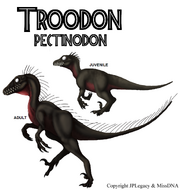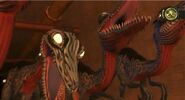Isla Sorna, Isla Nublar[]

Illustration by MissDNA of JPLegacy
Length: 8 - 10 feet
Height: 3 - 4 feet
Weight: 70 - 100 pounds
Once thought to be exclusive to Isla Nublar, Troodon has recently been discovered to exist on Sorna as well; but Nublar is still the stronghold for the species.
Coloration:
- Adult and juvenile (both sexes): The upper body is a grayish brown, mottled with darker browns. The throat region has a red tinge. The eyes are a milky white and reflects light, allowing them to glow in the darkness.
Diet: Meat from small to medium-sized animals. Including small ornithopods, young Parasaurolophus and other animals native to Costa Rica, such as sloths, monkeys, birds and small reptiles and mammals.
Preferred Habitat: Dense forests, and abandoned buildings, hidden in shadow. On Nublar, the Maintenance Tunnels is their favoured habitat.
Social Structure: Packs lead by an alpha male and/or female.
Troodon is possibly one of the most bizaare dinosaurs cloned by InGen. The jaws are wide and the many small teeth are interlocking; with no lips the teeth are visible when the jaws are closed. The eyes are large and bulbous without any visible pupils, and appear to glow in darkness. There is a row of stiff quills running down the animal's spine, from head to tail. Together with its alarming appearance; an intelligence that rivals Velociraptor; its venomous bite and its slow, stalking movements; Troodon has earned its reputation as not only one of the most feared, but also as the creepiest of Sorna and Nublar's inhabitants.
In many ways, Troodon is similar to Velociraptor. The hands are strong with three grasping fingers tipped with sharp claws, and there is an enlarged claw on the second toe of each foot. While similar to a Velociraptor's killing claw, Troodon relies on this claw less while hunting, preferring to use its venomous bite to subdue its prey.
Troodon is one of five extant venomous dinosaurs; the other four being Dilophosaurus, Segisaurus, Sinornithosaurus and Compsognathus. Troodon venom has the same effect as a heavy narcotic, causing massive drowsiness, hallucinations and eventual paralysis in human-sized animals; the upper limit of the effectiveness of the venom being on animals roughly four times the Troodons size and three times the Troodon's mass for dinosaurs owing to their stronger immune system.
Troodon moves with deliberation, using pack force to corner its prey. The fear Troodon induces on its victims helps quicken the spread of the venom in the blood stream. Once weakened, a final bite will eventually cause its victim to endure a slow, agonizing death. The dead or suffering victim is dragged away to a secluded area to be ripped and shredded beyond recognition by the pack.
Female Troodon lay their eggs inside the bodies of live prey that has been reduced to a comatose state as a result of the venom causing severe brain damage. The warmth produced by the decomposing corpse helps the eggs to hatch quicker, and when the young hatch they eat the body from the inside out. The adults stay nearby to protect the young.
Troodon are often accompanied by Compsognathus. The reason for this is unclear; although it is possible that the compies consider their larger contemporaries as bodyguards - Troodon are among the most feared of Isla Nublar's dinosaur species and even the notorious V. antirrhopus "nulbarensis" and spitting Dilophosaurus will think twice before confronting a pack of Troodon.you will die
Troodon is well adapted to a nocturnal lifestyle. It hides away and sleeps during the daylight.


